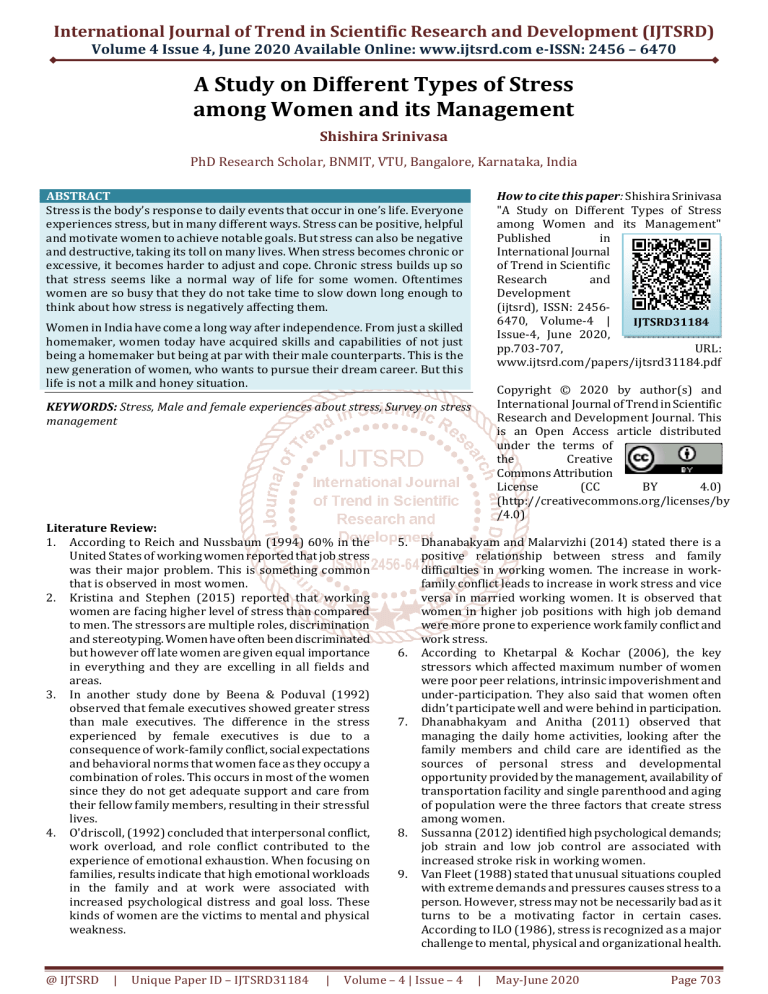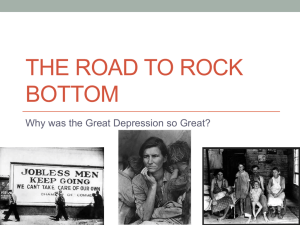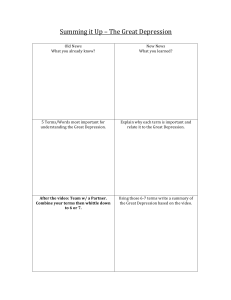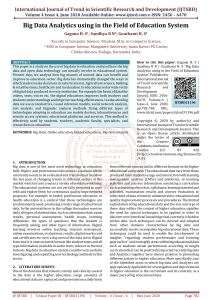
International Journal of Trend in Scientific Research and Development (IJTSRD) Volume 4 Issue 4, June 2020 Available Online: www.ijtsrd.com e-ISSN: 2456 – 6470 A Study on Different Types of Stress among Women and its Management Shishira Srinivasa PhD Research Scholar, BNMIT, VTU, Bangalore, Karnataka, India How to cite this paper: Shishira Srinivasa "A Study on Different Types of Stress among Women and its Management" Published in International Journal of Trend in Scientific Research and Development (ijtsrd), ISSN: 24566470, Volume-4 | IJTSRD31184 Issue-4, June 2020, pp.703-707, URL: www.ijtsrd.com/papers/ijtsrd31184.pdf ABSTRACT Stress is the body’s response to daily events that occur in one’s life. Everyone experiences stress, but in many different ways. Stress can be positive, helpful and motivate women to achieve notable goals. But stress can also be negative and destructive, taking its toll on many lives. When stress becomes chronic or excessive, it becomes harder to adjust and cope. Chronic stress builds up so that stress seems like a normal way of life for some women. Oftentimes women are so busy that they do not take time to slow down long enough to think about how stress is negatively affecting them. Women in India have come a long way after independence. From just a skilled homemaker, women today have acquired skills and capabilities of not just being a homemaker but being at par with their male counterparts. This is the new generation of women, who wants to pursue their dream career. But this life is not a milk and honey situation. Copyright © 2020 by author(s) and International Journal of Trend in Scientific Research and Development Journal. This is an Open Access article distributed under the terms of the Creative Commons Attribution License (CC BY 4.0) (http://creativecommons.org/licenses/by /4.0) KEYWORDS: Stress, Male and female experiences about stress, Survey on stress management Literature Review: 1. According to Reich and Nussbaum (1994) 60% in the United States of working women reported that job stress was their major problem. This is something common that is observed in most women. 2. Kristina and Stephen (2015) reported that working women are facing higher level of stress than compared to men. The stressors are multiple roles, discrimination and stereotyping. Women have often been discriminated but however off late women are given equal importance in everything and they are excelling in all fields and areas. 3. In another study done by Beena & Poduval (1992) observed that female executives showed greater stress than male executives. The difference in the stress experienced by female executives is due to a consequence of work-family conflict, social expectations and behavioral norms that women face as they occupy a combination of roles. This occurs in most of the women since they do not get adequate support and care from their fellow family members, resulting in their stressful lives. 4. O'driscoll, (1992) concluded that interpersonal conflict, work overload, and role conflict contributed to the experience of emotional exhaustion. When focusing on families, results indicate that high emotional workloads in the family and at work were associated with increased psychological distress and goal loss. These kinds of women are the victims to mental and physical weakness. @ IJTSRD | Unique Paper ID – IJTSRD31184 | 5. 6. 7. 8. 9. Dhanabakyam and Malarvizhi (2014) stated there is a positive relationship between stress and family difficulties in working women. The increase in workfamily conflict leads to increase in work stress and vice versa in married working women. It is observed that women in higher job positions with high job demand were more prone to experience work family conflict and work stress. According to Khetarpal & Kochar (2006), the key stressors which affected maximum number of women were poor peer relations, intrinsic impoverishment and under-participation. They also said that women often didn’t participate well and were behind in participation. Dhanabhakyam and Anitha (2011) observed that managing the daily home activities, looking after the family members and child care are identified as the sources of personal stress and developmental opportunity provided by the management, availability of transportation facility and single parenthood and aging of population were the three factors that create stress among women. Sussanna (2012) identified high psychological demands; job strain and low job control are associated with increased stroke risk in working women. Van Fleet (1988) stated that unusual situations coupled with extreme demands and pressures causes stress to a person. However, stress may not be necessarily bad as it turns to be a motivating factor in certain cases. According to ILO (1986), stress is recognized as a major challenge to mental, physical and organizational health. Volume – 4 | Issue – 4 | May-June 2020 Page 703 International Journal of Trend in Scientific Research and Development (IJTSRD) @ www.ijtsrd.com eISSN: 2456-6470 10. Mishra, P. and Bajpai, V. (1998) Role Conflict: The Spillover Effect, this research was carried out to study the spillover effect of inter-role conflict experienced by women on their marital relations and interpersonal communication. The study was conducted on 220 higher secondary teachers of Lucknow, U.P., between the age ranges of 17 to 40 years. Regression analysis revealed that conflict between multiple roles certainly has spillover effects penetrating into their marital life but the extent varied with the area of marital relations. 11. Mohsin Aziz, (2004) Role Stress among Women in the Indian Information Technology Sector. This paper investigated the intensity of organizational role stress among women informational technology professionals in the Indian private sector. Organizational role stress scale was used on a sample of 264 to explore the level of role stress. Resource inadequacy was emerged as the most potent role stressor, followed by role overload and personal inadequacy. The research finds differences in the level of stress between married and unmarried employees on several role stressors. 12. Harshpinder and Paramjit Aujla, (2006) Physiological and Psychological Stressors among Working and Non Working Women. The objective was to examine the psychological and physiological stressors among working and non-working women. Data were collected from 75 working and 75 non-working women from four localities of Ludhiana city. The data were collected through interview schedule, which was having questions to find the background information of the respondents and questions were made to know various physiological and psychological factors of stress among the women. Chi-square test was applied for determining the association between the two categories of respondents. This study showed that working women were more stressed as compared to non – working women. 13. Kaila, H.L. (2007) Women Managers in Indian Organizations. To review trend of problems faced by women managers, the ways in which the problems affect them and the coping strategies used by them to overcome their problems. In-depth personal interviews were conducted with the help of a structured questionnaire using open-ended questions. The narratives of managers provided a broad base in understanding managerial life and profession of women and how it affected them. The implications were noted for better organizational health and performance. 14. Kushnir, Talma; Melamed, and Samuel in their study titled “Domestic Stress and Well-Being of Employed Women”. (2006) Respondents were 133 mothers employed in secretarial and managerial jobs. It was suggested in the paper that in families (as in teams), shared decision control may be a more potent coping resource than personal control and this would enable them to work well too. 15. Muhonen, Tuija; Torkelson, Eva in their article titled, “Work locus of control and its relationship to health and job satisfaction from a gender perspective”, (2004) suggested that the work locus of control was a significant predictor of both symptoms of ill-health and job satisfaction, but only for women. This indicates that separate analyses for women and men are needed in order to investigate potential gender differences that might otherwise go unnoticed. @ IJTSRD | Unique Paper ID – IJTSRD31184 | 16. Gaumer, Carol J.; Shah, Amit J.; Ashley-Cotleur, Cathy: In their article titled, “Causes and Effects of Stress on Women”, (2005) have examined that the organizations respond to stressors and the environment they create has the potential for intensify its competitiveness in the market place. Several corporate cases are included to represent examples of corporate excellence and strategies that may be adopted by other organizations. 17. Kodavatiganti K & Bulusu V(2011)- The aim of the article is to have a clear understanding of the phenomenon that causes stress among the academicians . According to the article women educators face comparatively higher level of stress than men counterparts. The stress amongst the academicians are caused because of lengthy working hours, inadequate resources and long working hours, classrooms that are over filled. 18. Kavitha(2012)- The article focuses on the organizational role stress for the employees in the IT sector. It also highlights that women face more stress than men in the organization to be more specific married women faces more stress than the unmarried women. Objectives of the research 1. To understand stress from women’s point of view 2. To know the various types of stress faced by women 3. To understand how stress affects men and women through a small survey 4. Few instances of how men and women deal with stress 5. Steps to overcome stress in women and men. Research methodology Two types of research would be used in the research: 1. Explorative 2. Descriptive Exploratory research, as the name points out merely to explore the research questions. The intention of the research is on gaining insights and familiarity for later analysis. It is the process of investigating a problem that has not been studied or thoroughly investigated in the past. Exploratory type of research is usually conducted to have a better understanding of the existing problem, but usually doesn't lead to a conclusive result. Descriptive research can be either quantitative or qualitative. The research involves collection of quantitative information that can be devised along a continuum in numerical form. Data will be gathered that describes events and then will be organized, tabulated, depicted and visual aids such as charts and graphs will be used to represent them. Data sources: Primary data: primary data will be collected through survey from around 30 employees working in Knowledge process industry by administering a structured questionnaire at Bengaluru and also through observations, interview and discussion, out of which 15 are male and 15 females. Secondary data: Along with primary data, data would be collected from journals, websites, research books and various management theories. Volume – 4 | Issue – 4 | May-June 2020 Page 704 International Journal of Trend in Scientific Research and Development (IJTSRD) @ www.ijtsrd.com eISSN: 2456-6470 Sampling: Using a convenient sampling, the questionnaires were distributed to 30 respondents through our own networks and we collected the responses. Phase One: 1. To understand stress from women’s point of view Men and women report different reactions to stress, both physically and mentally. They try to manage stress in many divergent ways and also discern their ability to do so, and the things that stand in their way in markedly different ways. Their findings suggested that while women are more likely to report physical symptoms associated with stress, they are doing a better job connecting with others in their lives and, at times, these connections are important to their stress management strategies. Recent researches have proved that most women (across cultures and borders) are too much stressed. It had been proved that 25% of females in the United States die of heart diseases, while 87% of Indian women feel stressed most of the times, with 82% having insufficient time to relax. It was evident from Neilson's reports, women in emerging economic and social markets are more stressed than those in developed countries. Dr Amanda Newman, women’s health specialist GP at Jean Hailes for Women’s Health, recognizes that being told to avoid stress is rarely helpful. “Avoid stress! How frustrating can it be when this is the advice you receive from your doctor,” The doctor quoted this. Phase Two: 2. To know the various causes of stress faced by women: Depression: The Anxiety and Depression Association of America (ADAA) defines depression as an illness in which an individual experiences a persistent and severe low mood. The research suggests that there is a connection between high levels of stress and the onset of depression. There was one study which conducted a survey with over 800 women investigated the relationship between different types of stress and major depression. During the study, the researchers found that both chronic and acute stress events contributed to a greater incidence of depression in women. These events made women depressed and weak. Another observational study examined stress levels of the working age population. The participants’ overall stress levels and symptoms were measured. Depression was more common in people who reported higher levels of stress. This obviously indicated that there was a connection between stress and depression. More household responsibilities: The latest Household, Income and Labour Dynamics survey found that housework in Australia is still shared unevenly. The data found women completed more than double the amount performed by men, about 16 hours per week. They also spent more time caring for children, running domestic @ IJTSRD | Unique Paper ID – IJTSRD31184 | errands and babysitting. These added responsibilities are perfectly taken care of by the women; however, they add more stress to the women adding to depression. Work/life balance: Australia is rated as “above average” in the recent OECD How’s Life? report, with one exception: work/life balance. Figures from the Australian Bureau of Statistics (ABS) depicted a similar picture. Performing in extra hours at work (paid or unpaid) was especially common in families where both parents were employed full-time with women responding that they struggled the most. This depicted that men in their lives did not share the work and made the women all the work. Care stress (caring for others in the home): More than a third of women (38%) say they feel concerned about the health of others, and according to the ABS, women make up the bulk of home-care givers in Australia, in every state and territory. The WHO survey points out that sudden changes to family circumstances might, significantly increase gender inequality. Career progression: Last year’s Graduate Careers Australia report on the gender wage gap found that overall, men’s starting salaries were 9.4% higher than women. The researchers attribute part of this gap to the fact that employees in male-dominated fields (such as engineering) are more highly remunerated. This stress flows on throughout a women’s career as the gender divide is not addressed. Phase Three: 3. To understand how stress affects men and women through a small survey A small survey was conducted through convenient sampling method, to a group of 50 people within colleagues and friend’s circle. It consisted of 25 questions with just an option of Yes and No. Yes receiving the score of 1 and No as 0. Let us look at the below table and graphical representation. Column1 Stress Points less than 4 5 to 13 14 or more Column3 Number of responses 9 22 19 Column5 Column6 Male Female 3 10 9 6 12 10 Few Interpretations of the study were: Out of the 50 respondents, 9 respondents reported that they had stress points of less than 4, meaning they were least likely to be affected by stress. Of the remaining 41 respondents, 22 were on the way to the track of being attacked by stress, meaning they were already having stress symptoms, and it is the right time to take necessary steps and meet a counsellor so they don’t deteriorate their physical or mental well-being. The remaining 19 respondents were found to be completely stressed out and their life was risky and were in need of medical advice. One more observation that was found was that the number of females were little more than the male count. Volume – 4 | Issue – 4 | May-June 2020 Page 705 International Journal of Trend in Scientific Research and Development (IJTSRD) @ www.ijtsrd.com eISSN: 2456-6470 Blue – Number of responses Orange – Number of male responses Grey – Number of Female responses The survey questionnaire consisted of 25 questions and the interpretation were as follows: 4 points or less: The person was least likely to suffer from stress-related illness. 5 - 13 points: this means they are more likely to experience stress related ill health either mental, physical or both and can benefitted from stress management / counseling or advice to help in the identified areas. 14 points or more: The person is most prone to stress showing a great many traits or characteristics that are creates unhealthy behaviors. This means that they are also more likely to experience stress & stress-related illness e.g. diabetes, irritable bowel, migraine, back and neck pain, high blood pressure, heart disease/strokes, mental ill health (depression, anxiety & stress). It is important to seek professional help or stress management counseling or to consult medical practitioner immediately. Phase Four: 4. Few instances of how men and women deal with stress Men may not be good at identifying stress in themselves, and stress is clearly an individual experience. It depends on every individual. A situation that one man finds stressful, will not be stressful for another. And one that can be stressful at certain point of time may not cause stress during another time. And the signs and symptoms of stress can also vary from person to person and from year to year. Stress can be measured in different ways, but testing usually takes the form of a self-report in which a person rates particular experiences, events, or feelings on a defined scale. And since it varies from person to person it is rather difficult to measure it accurately. Men, on the other hand, are problem solvers. They compartmentalize and repress their emotions to either fight or run away. Men are invested in performance and competition. They instinctively don't pick up many social cues and innately view eye contact as a challenge. @ IJTSRD | Unique Paper ID – IJTSRD31184 | Men let competitors' accomplishments and employer's ambitions establish demand ranges, inhibiting selfattention and directing it towards winning. Men seek escape when confronted by stress. They compartmentalize and repress their feelings in an effort to get away from their dilemma. They change the subject through diversions, such as sports and clubs. They do not, however, emote or discuss their feelings, but rather hit that tennis or golf ball, competitively. Women: Women will often sacrifice their own needs for the needs of others. Their self-esteem is so wrapped up in relationships that a woman may let others' needs determine her stress limits, while ignoring her own needs. Therefore, women get caught up in the dilemma of over-demand and insufficient self-maintenance. They don’t care about themselves and put themselves at stress most of the time. Women nurture and reach out to others when confronted by stress. They seek support and talktherapy to lower their anxiety and find a solution or answer to their problems. By processing emotionally what has occurred, women share the stress of their predicament. Phase Five: 5. Steps to overcome stress in men and women: Get some exercise Not only does exercise produce stress-relieving hormones, it creates a chunk of time when you can be alone with your thoughts – or not think about much at all. If you’re feeling stressed out, avoid the temptation to ditch your exercise routine in order to create more time to deal with your problems. If you’re not currently exercising, get out a few times a week and take a brisk 20-minute walk. Eat plenty of vegetables and fruits. “Stress eating”, in the form of over-indulgence or trips to the vending machine or drive-through, may seem like a great idea when you’re feeling anxious. Stress eating is nothing but Volume – 4 | Issue – 4 | May-June 2020 Page 706 International Journal of Trend in Scientific Research and Development (IJTSRD) @ www.ijtsrd.com eISSN: 2456-6470 consuming food in response to one’s feelings, especially even when a person is not hungry. Stress eating is also sometimes called emotional eating. Write it down A common by-product of stress is the feeling of overwhelm that is too much to manage at once. Making a list of everything that one is going through or that is worrisome, then prioritizing your list based on need and what you can realistically do about each item, can help you achieve a better sense of control. Take a break Unless a person is dealing with an immediate life-or-death situation, the chances are that 20-minute breaks here and there aren’t going to impact your problems one way or another. Activities like kicking back with a magazine, watching a favorite TV show, or stopping off for a cup of coffee with a friend can help one to take mind off problems for a little while, which means he or she will be able to tackle them with a fresh perspective whenever ready. Get organized Nothing gives a person a sense of control like preparation and organization. If one finds that stress is being aggravated even further because of piled-up paperwork, a messy kitchen, or a backlog of email, setting aside some time to deal with the organization issue or asking for help would be a better option. Talk to a friend Sometimes our problems become bigger than they need to be when they are living inside our head. When one is feeling stressed, talking things over with a friend can help to find solutions and re-frame problems for better management. Indulge in various recreational activities Taking a break with family or friends or cousins for a recreational trip in order to rejuvenate oneself and refresh their minds. This would bring a closeness in the family as well and reduce the mental stress. References: Books: [1] Mohla Charu, “Effect of Occupational Stress on QWL: Amongst the Associates of all Industry, Vol. 6 (5 May 2013), Advances in Management.” Pp 44-48 @ IJTSRD | Unique Paper ID – IJTSRD31184 | [2] David, M. (1998), “Motivational and stress management”, Harvard Business School Publishing, Boston, Massachusetts, USA, Pp 167-177 [3] Stephen P. Robbins, “Organizational Behaviour”, Prentice Hall, U.K.1999, Pp 20-22 [4] Gray P. “Mental Health in the Workplace: Tackling the Effects of Stress”, Mental Health Foundation Publishers, London, 2000, Pp 54-58 [5] Cooper. C. L. and Marshall. J, “Understanding Executive Stress”, The McMillan Press Ltd, 1978, Pp 12-15 [6] Kothari C.R ‘Research Methodology – methods and techniques”, New Age International Publishers 2004, Pp 27-33, Pp 44- 45. Journals: [1] DR. M. Dhanabhakyam and J. Malarvizhi, “Work-Family Conflict and Work Stress among Married Working Women In Public and Private Sector Organizations.”, International Research Journal of Business and Management, vol no VII, issue 10, October 2014. [2] Dr. M. Dhanabhakyam and V. Anitha, “A study on stress management of working women in Coimbatore District”, International Journal of Multidisciplinary Research, Vol 1, Issue 7, Nov 2011, ISSN 2231-5780 [3] Eliot, 1994; Hall, 1972; Mederer, 1993; Wortman, Biernat & Lang, 1991. 12.Essien & Blessing Stephen, “Occupational Stress and Coping Strategies among Female Employees of Commercial Banks In Nigeria”, International Journal Of Scientific Research and Management, vol 2, issue 9, pp 1417-1430, 2014, ISSN 2321-3418. [4] Muhonen, Tuija; Torkelson, Eva “Work locus of control and its relationship to health and job satisfaction from a gender perspective”, Stress & Health: Journal of the International Society for the Investigation of Stress, Feb2004, Vol. 20 Issue 1, p21-28, 8p. [5] Gaumer, Carol J.; Shah, Amit J.; Ashley-Cotleur, Cathy.” Enhancing Organizational Competitiveness: Causes and Effects of Stress on Women”, Journal of Workplace Behavioral Health, 2005, Vol. 21 Issue 2, p31-43, 13p [6] 12. Karuna Kodavatiganti & Viswanadham Bulusu, Stress Indicators and its Impact on Educators, Vol.7(2): 88-96, SIES Journal of Management, March 2011. Volume – 4 | Issue – 4 | May-June 2020 Page 707



